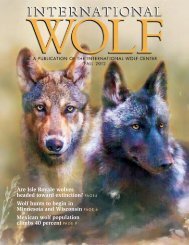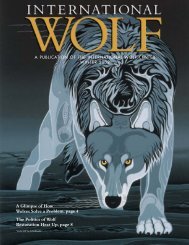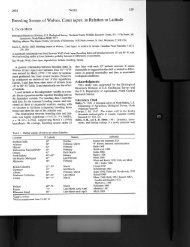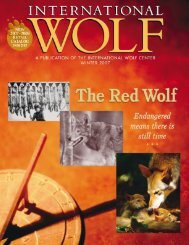a publication of the international wolf center spring 2007
a publication of the international wolf center spring 2007
a publication of the international wolf center spring 2007
Create successful ePaper yourself
Turn your PDF publications into a flip-book with our unique Google optimized e-Paper software.
Barron Crawford, U.S. Fish and Wildlife Service<br />
WOLVES IN THE<br />
UNITED STATES<br />
Back to <strong>the</strong> Wild:<br />
The Twentieth<br />
Anniversary <strong>of</strong><br />
<strong>the</strong> Red Wolf<br />
Reintroduction<br />
by Cornelia Hutt<br />
In 1980, red wolves were considered<br />
extinct in <strong>the</strong> wild. Habitat<br />
destruction and human persecution<br />
had forced <strong>the</strong> last red wolves<br />
into marginal habitat along <strong>the</strong> Texas<br />
and Louisiana coasts, where <strong>the</strong>y interbred<br />
with coyotes and succumbed to<br />
parasite infestation. After years <strong>of</strong><br />
captive breeding, eight red wolves<br />
consisting <strong>of</strong> four breeding pairs were<br />
reintroduced to <strong>the</strong> wild in 1987 at<br />
<strong>the</strong> Alligator River National Wildlife<br />
Refuge (ARNWR) in nor<strong>the</strong>astern<br />
North Carolina. This was <strong>the</strong> first<br />
attempt ever to restore an <strong>of</strong>ficially<br />
extinct carnivore to a portion <strong>of</strong> its<br />
historic range.<br />
No one knew if <strong>the</strong> wolves would<br />
make it. Would <strong>the</strong>y learn to hunt?<br />
Would <strong>the</strong>y breed successfully in<br />
<strong>the</strong> wild? Would <strong>the</strong>y adjust to <strong>the</strong><br />
humid heat <strong>of</strong> <strong>the</strong> coastal summers<br />
and <strong>the</strong> chill <strong>of</strong> raw winters?<br />
Make it <strong>the</strong>y did! One year after<br />
<strong>the</strong> reintroduction, <strong>the</strong> first litter <strong>of</strong><br />
red <strong>wolf</strong> pups was born in <strong>the</strong> wild<br />
on <strong>the</strong> ARNWR. During <strong>the</strong> ensuing<br />
20 years, many more pups have been<br />
Brad McPhee, U.S. Fish<br />
and Wildlife Service<br />
The first litter<br />
<strong>of</strong> red <strong>wolf</strong> pups was<br />
born in <strong>the</strong> wild on <strong>the</strong> ARNWR in 1988. Since<br />
<strong>the</strong>n, <strong>the</strong> population has expanded to over 100<br />
wolves roaming free in a five-county area.<br />
born and survived. The population<br />
has expanded to over 100 wolves<br />
roaming free in a five-county area that<br />
includes two o<strong>the</strong>r wildlife refuges<br />
and pockets <strong>of</strong> private land as well.<br />
The Red Wolf Recovery Team has<br />
faced a number <strong>of</strong> obstacles throughout<br />
<strong>the</strong> years and has met each<br />
challenge with science-based action<br />
plans and on-<strong>the</strong>-ground fieldwork.<br />
However, in spite <strong>of</strong> <strong>the</strong> successes<br />
<strong>of</strong> <strong>the</strong> recovery program, red wolves<br />
continue to die because <strong>of</strong> humans. At<br />
one time, vehicular accidents were<br />
<strong>the</strong> number one cause <strong>of</strong> adult red <strong>wolf</strong><br />
mortality. Today, and over <strong>the</strong> past<br />
several years, gunshot and “suspicious<br />
circumstances” are <strong>the</strong> primary causes<br />
<strong>of</strong> adult red <strong>wolf</strong> deaths.<br />
In response to an alarming loss<br />
<strong>of</strong> red <strong>wolf</strong> breeders, <strong>the</strong> Red Wolf<br />
Recovery Program in partnership<br />
with <strong>the</strong> Red Wolf Coalition and<br />
Defenders <strong>of</strong> Wildlife has launched a<br />
major hunter education initiative.<br />
Thousands <strong>of</strong> hunter education cards<br />
(shown above) have been distributed<br />
throughout <strong>the</strong> state. This walletsized<br />
card helps hunters distinguish<br />
red wolves from eastern coyotes<br />
and promotes <strong>the</strong> message, “Don’t<br />
Shoot!” east <strong>of</strong> NC State Highway 32.<br />
The Red Wolf Coalition is seeking<br />
funding to develop a permanent<br />
exhibit that will demonstrate <strong>the</strong><br />
benefit red wolves bring to hunters<br />
and farmers in rural nor<strong>the</strong>astern<br />
North Carolina. We want <strong>2007</strong> to be<br />
a year <strong>of</strong> celebration for <strong>the</strong> red <strong>wolf</strong><br />
and for <strong>the</strong> people who are determined<br />
to ensure its long-term<br />
survival in <strong>the</strong> wild.<br />
For more information about <strong>the</strong> Red Wolf<br />
Coalition, visit <strong>the</strong> Web site at www.red<br />
wolves.com, or go to http://www.fws.<br />
gov/alligatorriver/red<strong>wolf</strong>.html.<br />
Cornelia Hutt is an educator and<br />
International Wolf Center board member<br />
who lives in Purcellville, Virginia.<br />
International Wolf Spring <strong>2007</strong> 17







